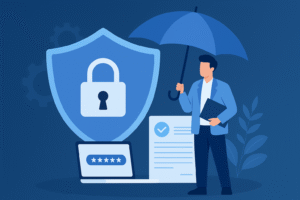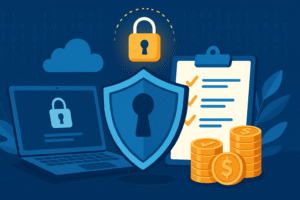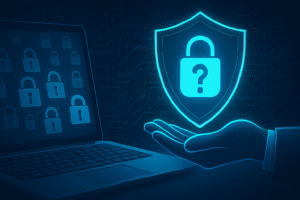Introduction
Cyberattacks aren’t a question of if anymore it’s when. For businesses large and small, cyber threats like ransomware, phishing, and data breaches are escalating in frequency and damage. A single breach can halt operations, drain finances, and tarnish reputations overnight.
Cyber insurance has become a non-negotiable lifeline for modern businesses. Beyond merely covering losses, it offers robust tools to help companies bounce back quickly and efficiently. From legal assistance to public relations crisis management, cyber insurance plays a pivotal role in ensuring business continuity after a cyberattack.
In this guide, we’ll dive deep into how cyber insurance supports your business post-hack. Whether you’re a startup founder, an IT manager, or a CEO, understanding this safety net can mean the difference between survival and shutdown.
🔻 The Growing Threat of Cyberattacks
Every 39 seconds, a cyberattack occurs. And with increasing dependence on digital infrastructure, the threat only grows. Hackers don’t discriminate SMBs, nonprofits, and enterprises are all at risk. Cyberattacks now cost businesses an average of $4.45 million globally, according to IBM’s 2023 Cost of a Data Breach Report.
Treat cybersecurity like fire safety preparation and protection are cheaper than damage repair.
🚨 Cyber Threat Reality Check
cyberattacks
breach cost
Targeted
Frequency
Impact
🔐 Why Cyber Insurance is Crucial for Modern Businesses
Cyber insurance doesn’t just mitigate financial loss. It provides a strategic framework for rapid response, business recovery, and future prevention. It can also serve as a crucial trust signal for stakeholders and customers.
According to PwC, 64% of businesses with cyber insurance say they resumed operations within a week after a major breach compared to just 30% without it.
Make cyber insurance part of your broader risk management and disaster recovery plan.
1. 💰 Immediate Financial Support
Typical Cyber Incident Costs
Typical Cyber Incident Costs
$850K
Forensics & Investigation
$1.2M
Lost Revenue
$600K
System Recovery
© 100khits.com
Typical Cyber Incident Costs
Coverage for Direct Losses
Cyber insurance kicks in fast. It covers immediate financial losses such as stolen funds, damaged hardware, or data loss. This ensures your business doesn’t bleed cash while you scramble to respond.
Direct loss coverage may include:
- Cost of forensics and breach investigation
- Hardware replacement
- Lost revenue from service interruptions
Helping Businesses Stay Afloat
Think of this coverage as a financial shock absorber. It buys you time to focus on recovery instead of worrying about liquidity or lines of credit.
Keep a record of all your IT assets and data backups to streamline claims processing.
2. 💾 Coverage for Data Recovery
Data Restoration and Replacement
When critical files are corrupted or lost in a breach, restoring or recreating that data is both expensive and time-consuming. Cyber insurance can cover these costs, helping you retrieve and repair data without delay.
Importance for Operational Recovery
Data recovery support reduces downtime and accelerates the return to business as usual—crucial for businesses that rely heavily on digital assets like customer databases or intellectual property.
Use redundant cloud backups and version histories insurers love proactive measures.
3. 📉 Business Interruption Compensation
Business Shutdown Risk Timeline
Business Shutdown Risk Timeline
24 Hours: Initial impact assessment, emergency response activated
48 Hours: Revenue loss accelerates, customer complaints increase
72 Hours: CRITICAL POINT - 90% risk of permanent closure
© 100khits.com
Business Shutdown Risk Timeline
Income Loss Reimbursement
If your systems go down, you’re likely losing sales and productivity. Cyber insurance can cover lost income during the interruption, including ongoing expenses like payroll and rent.
Companies that can’t operate digitally for more than 72 hours face a 90% risk of long-term closure.
Keeping Operations Running
With financial assistance in place, you can focus on restoring workflows without making knee-jerk cost cuts.
Build a simple calculator to estimate your daily revenue helps speed up your claim.
4. ⚖️ Legal and Regulatory Support
Legal Fee Coverage
Following a breach, legal expenses can pile up fast. Cyber insurance can cover:
- Defense against lawsuits
- Regulatory fines and penalties
- Legal consultation services
Compliance and Notification Support
Most jurisdictions require timely notification to affected individuals and data authorities. Cyber insurance helps businesses navigate these tricky waters by offering compliance and disclosure assistance.
“Cyber insurance fills a critical gap in compliance readiness for GDPR and other laws,” notes a legal consultant at Norton Rose Fulbright.
Pre-select a breach attorney to reduce response time during a crisis.
5. 🌐 Reputation Management
Public Relations Services
A data breach can lead to serious reputational damage. Many cyber insurance policies provide access to PR professionals to manage media responses, draft statements, and handle damage control.
Rebuilding Customer Trust
Clear, honest communication guided by experts helps restore confidence in your brand, reducing churn and bad press.
Prepare a customer-facing incident response template before a breach happens.
6. 👨💻 Access to Cybersecurity Experts
Incident Response Teams
Most policies include immediate access to incident response experts digital forensics teams, IT professionals, and breach coaches to contain and investigate the hack.
A coordinated cyber response reduces breach costs by an average of 30%, according to Verizon’s Data Breach Investigations Report.
Preventing Future Attacks
Insurers often recommend or subsidize upgrades to your systems after analyzing the breach, helping you avoid repeat incidents.
Schedule a tabletop exercise with your team using your insurer’s response plan.
7. 🦠 Support for Ransomware Attacks
Ransom Payment and Negotiation
If your systems are locked down by ransomware, cyber insurance may cover:
- Ransom payment (if legally permitted)
- Expert negotiators to handle communication
Safe Data Retrieval
Insurers also provide vetted decryption tools and technical specialists to safely retrieve data and resume operations.
Don’t negotiate with hackers yourself use your insurer’s negotiator immediately.
🚨 Ransomware Attack Flow & Response
Understanding how ransomware attacks unfold and proper response procedures can save your business millions.
Without Insurance: 3-8 weeks average recovery
- Regular automated backups (3-2-1 rule)
- Employee security awareness training
- Multi-factor authentication everywhere
- Network segmentation and monitoring
- Incident response plan testing
8. 🔗 Third-Party Liability Coverage
Protection Against Customer Claims
If client data is exposed, customers might file lawsuits. Cyber insurance covers defense costs, settlements, and regulatory fines, ensuring your business isn’t crippled by legal blowback.
Supply Chain Risk Mitigation
A hack in your supply chain can also affect you. Third-party cyber liability ensures you’re protected even if the breach wasn’t directly your fault.
Vet your vendors for cybersecurity compliance and keep proof on file for insurers.
9. 🧠 Employee Training and Awareness
Insurer-Provided Resources
Many policies offer free or subsidized cybersecurity training for staff phishing simulations, security best practices, and password hygiene.
Building a Security Culture
Training helps reduce human error, the cause of over 82% of data breaches, according to a 2023 Verizon study.
Create a reward system for employees who report phishing or suspicious activity.
10. 🔄 Long-Term Business Resilience
Strengthening Cyber Defenses
Insurers conduct post-breach assessments and recommend future safeguards, such as MFA, endpoint monitoring, and zero-trust frameworks.
Enhancing Continuity Planning
You also gain insights into gaps in your continuity plan. Many insurers even offer continuity consulting as part of your policy.
Ask your insurer for an annual security audit to adjust coverage as your business evolves.
📊 Coverage Comparison: With vs Without Cyber Insurance
Understanding what cyber insurance covers versus going without protection is crucial for making informed business decisions.
| Coverage Area | With Insurance | Without Insurance | Cost Impact |
|---|---|---|---|
| Incident Response | ✓ 24/7 expert support | ✗ DIY response | $50K-$200K saved |
| Legal Support | ✓ Full coverage | ✗ Out-of-pocket | $100K-$500K saved |
| Data Recovery | ✓ Professional | △ Limited options | $75K-$300K saved |
| Business Interruption | ✓ Revenue covered | ✗ Total loss | $500K-$2M saved |
| PR Support | ✓ Crisis experts | ✗ Reputation damage | $25K-$150K saved |
| Ransomware | ✓ Negotiation | ✗ Pay or lose data | $50K-$1M saved |
| Notifications | ✓ Automated | ✗ Manual process | $10K-$50K saved |
| Third-Party Claims | ✓ Full protection | ✗ Unlimited exposure | $200K-$5M saved |
| Investigation | ✓ Expert analysis | △ Basic only | $30K-$150K saved |
| Recovery Time | ✓ 1-7 days avg | ✗ 2-8 weeks avg | Operational continuity |
✅ Conclusion
Cyber insurance does more than reimburse you it equips you. From ransomware negotiations to PR support, legal guidance to expert response teams, it acts as a powerful toolkit for recovery. In an era where digital risks are business risks, cyber insurance is your anchor of business continuity, trust, and resilience.
Don’t wait for disaster to strike. Prepare now, protect always.
❓FAQs
Q1: Is cyber insurance worth it for small businesses?
Absolutely. Small businesses are often targeted due to weaker defenses. Cyber insurance helps them recover quickly without draining limited resources.
Q2: What does cyber insurance not cover?
Most policies exclude prior known incidents, internal fraud, and failure to follow basic security practices like regular updates.
Q3: How fast can cyber insurance claims be processed?
Many insurers offer 24/7 hotlines and can initiate support within hours. Complete recovery depends on the scope of the breach.
Q4: Is ransomware covered by all cyber insurance policies?
Most do, but always check for exclusions or limits. Some policies only cover negotiation, not payment.
Q5: Does cyber insurance help with compliance?
Yes. It often includes legal consultation, breach notification templates, and compliance reporting support.








